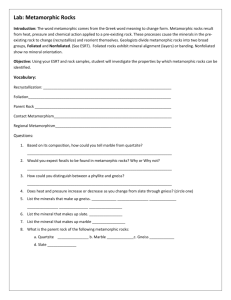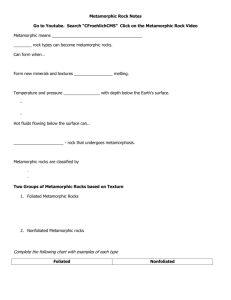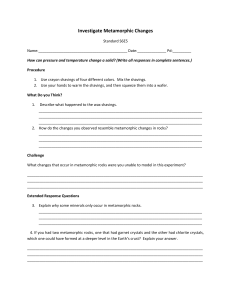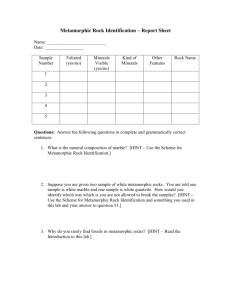Metamorphic Rock Direct Reading
advertisement
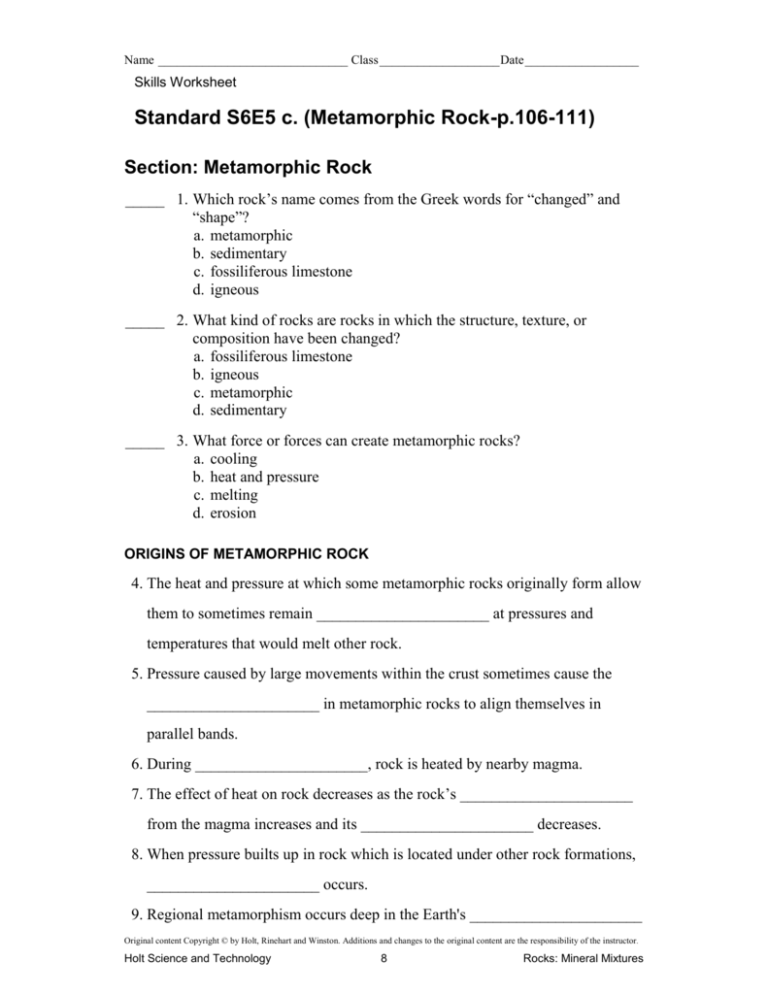
Name ______________________________ Class ___________________ Date __________________ Skills Worksheet Standard S6E5 c. (Metamorphic Rock-p.106-111) Section: Metamorphic Rock _____ 1. Which rock’s name comes from the Greek words for “changed” and “shape”? a. metamorphic b. sedimentary c. fossiliferous limestone d. igneous _____ 2. What kind of rocks are rocks in which the structure, texture, or composition have been changed? a. fossiliferous limestone b. igneous c. metamorphic d. sedimentary _____ 3. What force or forces can create metamorphic rocks? a. cooling b. heat and pressure c. melting d. erosion ORIGINS OF METAMORPHIC ROCK 4. The heat and pressure at which some metamorphic rocks originally form allow them to sometimes remain ______________________ at pressures and temperatures that would melt other rock. 5. Pressure caused by large movements within the crust sometimes cause the ______________________ in metamorphic rocks to align themselves in parallel bands. 6. During ______________________, rock is heated by nearby magma. 7. The effect of heat on rock decreases as the rock’s ______________________ from the magma increases and its ______________________ decreases. 8. When pressure builts up in rock which is located under other rock formations, ______________________ occurs. 9. Regional metamorphism occurs deep in the Earth's ______________________ Original content Copyright © by Holt, Rinehart and Winston. Additions and changes to the original content are the responsibility of the instructor. Holt Science and Technology 8 Rocks: Mineral Mixtures Name ______________________________ Class ___________________ Date __________________ Directed Reading A continued TEXTURES OF METAMORPHIC ROCK _____ 10. What do we call metamorphic rocks in which mineral grains are NOT aligned in planes or bands? a. foliated b. intrusive c. nonfoliated d. extrusive _____ 11. What do we call metamorphic rocks in which mineral grains are aligned in planes or bands? a. foliated b. intrusive c. nonfoliated d. extrusive _____ 12. What is the process in which a mineral changes composition during metamorphism called? a. recrystallization b. nonfoliation c. foliation d. deformation _____ 13. After quartz limestone has recrystallized, the new rock is called a. schist. b. gneiss. c. slate. d. quartzite. METAMORPHIC ROCK STRUCTURES _____ 14. What is a change in the shape of a rock caused by a force placed on it called? a. deformation b. recrystallization c. foliation d. nonfoliation 15. Which do you think would be easier to break, a foliated rock, such as slate, or a nonfoliated rock, such as quartzite? Explain. Original content Copyright © by Holt, Rinehart and Winston. Additions and changes to the original content are the responsibility of the instructor. Holt Science and Technology 9 Rocks: Mineral Mixtures Name ______________________________ Class ___________________ Date __________________ Original content Copyright © by Holt, Rinehart and Winston. Additions and changes to the original content are the responsibility of the instructor. Holt Science and Technology 10 Rocks: Mineral Mixtures



